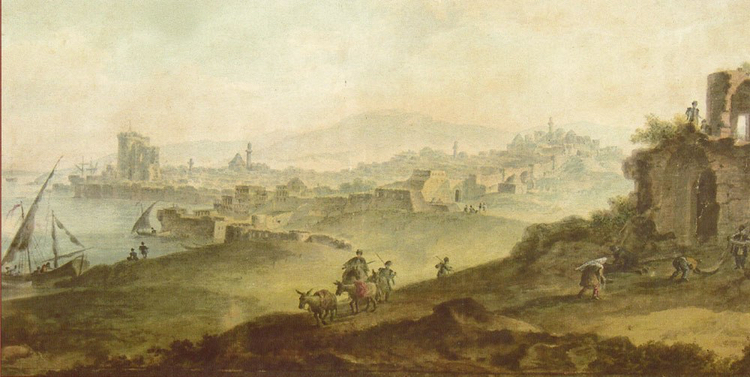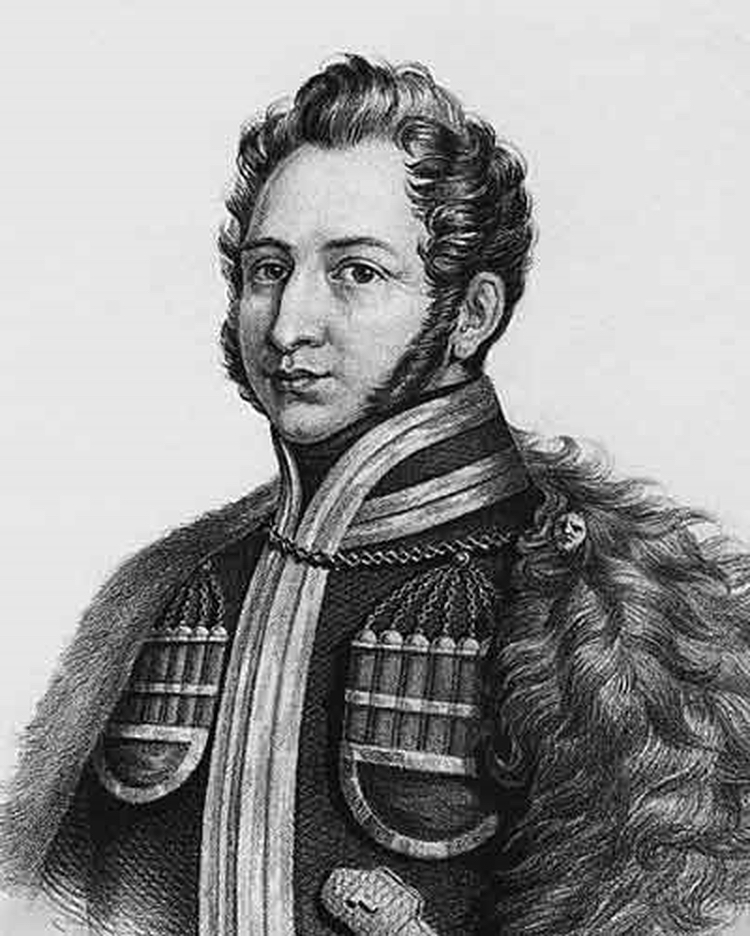The period of the Khanate
The Baku khanate was one of the feudal states established in the 40ies of the 18th century on the Absheron peninsula.
During the last period of the Safavids’ rule, Baku and its surroundings were ruled as a “country” by hereditary rulers with the title of sultan. In the early 20s of the 18th century, the sultan of Baku was Mahammadhuseyin bey. In 1722, when the Russian Tsar Peter I attacked Azerbaijan with a great army Mahammadhuseyin bey offered decent resistance refusing to surrender to the Russians. In late July 1723, the Russian army headed by General Matyushkin approached the city with ships and subjected it to gunfire, after 4 days of fight the city was surrendered.
After the Russians seized the city, Sultan Mahammadhuseyin bey and his four brothers were arrested and exiled first to Astrakhan and then to Rogachevsk. The management of the city was entrusted to the Russian officer Brigadier Baryatinsky. Fireworks on the occasion of the capture of Baku took place in St. Petersburg.
With the death of Peter I in 1725, Russia’s interest in the Caspian Sea states diminished.
After the capture of the supreme power by Nadir Shah in 1747, the Baku Khanate achieved complete independence from Russia. In 1747, Nadir Shah was killed, so Mirza Mahammad khan using his influence in Baku, declared himself an independent ruler.
Baku Khanate covered a small territory of 75 versts long and a maximum of 30-40 versts wide – the whole Absheron Peninsula. From the east, from the north and from the south it was washed by the Caspian Sea, in the west, southwest it adjoined the Shamakhi Khanate, and in the northwest it adjoined the Guba Khanate. The capital of the khanate was the ancient city of Baku, which consisted of a fortress and suburbs and for a long time was fortified by fortress walls. More than 40 mortar shells were installed on the walls.

Watchtowers and forts were located 40 versts away from the city. The Maiden Tower, located in the southern part of the city, served not only as a watchtower, but also as a lighthouse for ships.
Though Baku was a political and important economic center, the population of Baku was small. According to 1796 data, there were only 1820 houses in Baku and the villages included in the khanate. If every household had five people, it became clear that more than 9,000 people lived in the khanate.
Baku was divided into 4 administrative units, each of which had its own headman.
The khanate comprised 39 villages: Guzdek, Gobu, Hokmali, Khirdalan, Haji Hasan, Bilajari, Saray, Masazir, Novkhany, Jorat, Fatmayi, Binagadi, Goradil, Kurdakhana, Pirshagi, Mashtaga, Bilgah, Nardaran, Buzovna, Shagan, Mardakan, Gala, Zira, Turkan, Digah, Amirjan, Surakhany, Bulbula, Ramana, Sabunchu, Zabrat, Balakhany, Ahmadli, Keshla, Kurkand and 4 hamlets – Pirakashkul, Hovsan, Zigh and Mahammadi.
The largest village of the Baku khanate was Mashtaga. The next largest villages were Gala, Balakhani, Novkhani and Buzovna.
The majority of the population of Baku khanate was the Azerbaijani Turks. Persian speaking Tats formerly resettled by Sassanids and then by Shah Abbas also lived here. 40 Armenian families resettled here by the Russians while Baku was under the Russian rule in the first half of the 18th century and a small number of Jews lived in the Baku khanate as well.
The Baku Khanate was a hereditary monarchy. After Mirza Mahammad khan (1747- 1768) the throne was ascended by his son Malik Mahammad khan (1768-1784) and his son Mirza Mahammad khan II (1784-1791). Later on, the khanate was ruled by the sons of Mirza Mahammad khan Mahammadgulu khan (1791-1792) and Huseyngulu khan (1792-1806).

All the administrative, financial, military, judicial power in the khanate was concentrated in the hands of the khan. There was a Diwan (consultative body at khan) in Baku khanate as in other khanates of Azerbaijan.
The state apparatus of the Baku Khanate was also very small. The close assistant of the Khan was the vizier. There was a position of naib (viceroy) as well. The headmen and centurions were subordinated to the viceroy.
There were also such positions as qalabeyi (fortress guard), dargha (functionary), etc. in the city of Baku. Being the commandant of the city, the fortress guard was also the police officer of the city, who was responsible for maintaining order in the city.
Baku khanate had almost no fertile lands, but was generously endowed with minerals. Baku was known for its oil since ancient times. The main oil wells were concentrated in Balakhany, Surakhany villages and in Bibi-Heybat. There were reports that there were oil fields on Pirallahy Island, too.
According to the sources, there were over 100 wells with black oil and 15 with white oil in Absheron at the end of the 18th century. About 240,000 poods of black and 8,000 poods of white oil was produced annually in Absheron.
The second important source of income in the Baku khanate was salt extraction. The salt was collected from the lakes Masazir, Zigh, Gala and Balakhany. The extracted salt was exported to the other khanates, as well as to Russia and Iran. 150 thousand poods of quality salt was extracted only from the Masazir lake per year. A rare plant in the world - saffron was grown in many villages of the khanate. From 100 to 400-500 poods of saffron was produced a year.
Almost all villages of the khanate had vineyards and orchards.
In coastal villages of the khanate people were successfully engaged in fishery.
The craft in Baku and nearby villages occupied one of the dominant places. The people were engaged in forging, dyeing, tailoring, shoemaking, hatting, plumbing, plasterwork, locksmith, bricklaying work and many other types of craft. Weaving, especially carpet weaving was highly developed. The villages of Bulbula, Amirjan and Surakhany were especially famous for their carpets.
There was a mint in Baku - zarrabkhana. Jewelry business and production of ceramic tableware were also developed.
Baku was the only shipbuilding center in Azerbaijan at that time. The necessary wooden raw materials were delivered from Guba and Talysh. Small boats were mainly built here.
In Baku khanate trade was conducted by two ways - by land and sea. Trade with other khanates of Azerbaijan, as well as with Turkey and Georgia was carried out by caravan routes, and with Russia and partly northern Iran by waterway.
The main monetary unit in the Baku khanate was the “abbasi”, but also the foreign currency was used.
There were frequent disputes between Baku khans and Russian traders over customs issues.
Constant struggle for power gradually weakened the Baku Khanate. Having seized an opportunity, the Government of Catherine II decided to transform the Baku Khanate into a protectorate of Russia in the autumn of 1795. However, since Aga Mahammad Khan Gajar was already in Northern Azerbaijan, the takeover of the Baku Khanate by Russia did not take place. Nevertheless, Huseyngulu khan who relied on Russia's assistance, refused to obey Aga Mahammad Khan Gajar.

When the Russian troops arrived in Baku in June 1796, Huseyngulu khan first wanted to resist, but then realizing that the resistance was in vain, he went to General Zubov's headquarters in Gilgilchay and submitted the keys of the fortress doors. Having accepted Huseyngulu khan, Zubov gave him a precious dagger. Russian troops entered Baku.
The Russian government intended to turn Baku into a supply base for its army. Immediate fortification of the Baku port began.
After the death of Catherine II in November 1796, the Russian troops committed a number of robberies during withdrawal from Azerbaijan. Thus, young men and girls were captured, about 1500 khalvar (old unit of measurement) of oil was burnt, copper and other household items, which were temporarily borrowed from the population were not returned, briefly, the city residents suffered severe damages.
In 1803, during the capture of Azerbaijan by the Russian government under the leadership of Pavel Tsitsianov, the Baku khanate was of great strategic importance. Tsitsianov, who could not subordinate the Baku khanate peacefully, decided to use military force.
On August 12, 1805, the Russian squadron entered the Baku bay. Two days later, Baku was subjected to gunfire from the land, and then from the sea. However, the residents of Baku bravely defended themselves.
At the end of November 1805, Tsitsianov with 1663 infantry and 10 cannons came from Ganja to Baku. On January 30, 1806, Tsitsianov's army approached Baku. Realizing the impossibility of opposing the Russian troops, Huseyngulu khan decided to use a stratagem. He sent a letter saying he was ready to accept the Russian authority. Tsitsianov believed in Khan and sent the terms of surrender of the city to Khan with lieutenant colonel Elizbar Eristov and Huseyngulu khan convinced him that he would hand over the keys of the fortress to him through the respected city elders.

On the morning of February 8, 1806, Tsitsianov, accompanied by 200 people, approached the water well, which was half a verst from the fortress walls. The city elders of Baku who came there presented the keys of the fortress and bread and salt to Tsitsianov, and asked for forgiveness of the khan for the resistance he offered. Tsitsianov, who took salt and bread, returned the keys and demanded that Huseyngulu khan submit them to him personally. Huseyngulu khan accompanied by his entourage left the fortress and presented the keys to general Tsitsianov. At that very moment when Tsitsianov accepted the keys, he and his escort Eristov were unexpectedly shot dead by two persons from the Khan's retinue. Khan's cousin Ibrahim bey killed Tsitsianov and Seyid bey and Emir Hamza killed Eristov.
The murder of the commander caused confusion and panic among the Russian troops. The Russian troops were forced to retreat to the island Sary, and from there to Kizlar.
Although the first military expedition to Baku did not succeed, the Russian government was not going to calm down. In the summer of 1806, the government issued an order that the new expedition be organized to launch an invasion of Baku.
Having occupied Derbent and Guba on the way the Russian troops approached Baku on October 3, 1806. Realizing the impossibility of resistance to much superior enemy forces Huseyngulu khan abandoned the city and took refuge in Gajars state with his family. This time Baku surrendered without a fight, the khanate was abolished and turned into a province ruled by the commandant.
In accordance with the Gulustan Treaty (1813) the Baku Khanate was officially annexed to Russia.
Later, the attempts to restore the Baku Khanate ended in failure.
Until Azerbaijan regained its independence in 1918, the city of Baku had remained subordinate to Russia.
